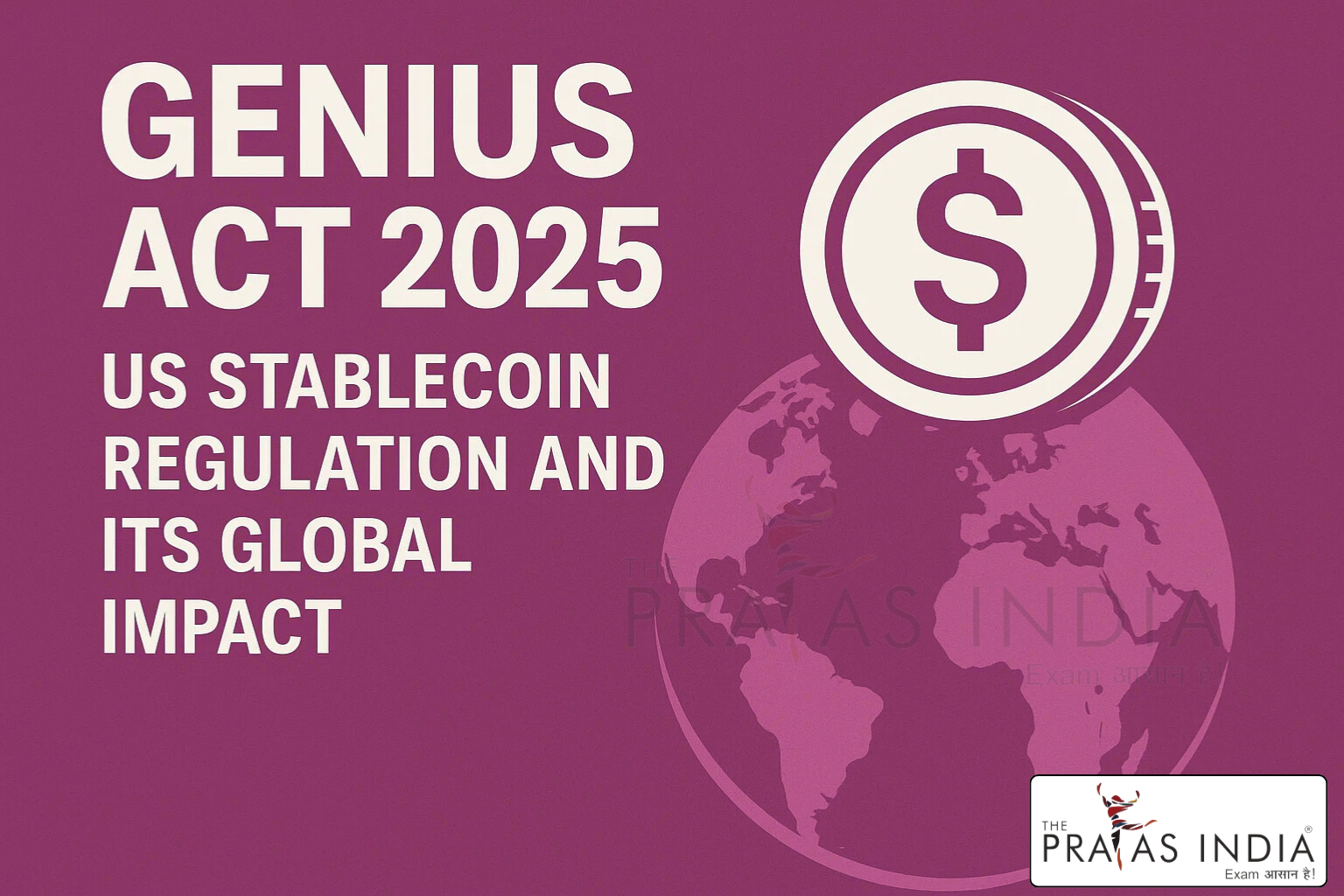GENIUS Act 2025: US Stablecoin Regulation and Its Global Impact
The digital currency landscape took a decisive turn in June 2025 as the United States Senate passed the GENIUS Act—a landmark law focused on the regulation of stablecoins, a category of cryptocurrencies designed to maintain a stable value by being backed with real-world assets like fiat currencies. With this move, the U.S. has taken a bold step in shaping the future of global digital finance, setting precedents that will influence financial systems, market sentiment, and even monetary sovereignty across the world.
This article explores the key features of the GENIUS Act, its implications for the global crypto market, the U.S. dollar’s dominance, and its relevance for India’s fintech sector, especially from a UPSC and economic policy analysis perspective.

💱 What Are Stablecoins?
Stablecoins are a form of cryptocurrency that aim to minimise price volatility by being pegged to traditional assets, most commonly the U.S. dollar. Unlike other cryptocurrencies like Bitcoin or Ethereum, stablecoins are designed for reliable value storage and seamless transactions.
As of mid-2025, stablecoins have a combined market capitalisation of $251.7 billion, reflecting a 22% rise over the previous year—an indication of rising trust and adoption in digital finance.
🧾 What Does the GENIUS Act Include?
The GENIUS Act (short for Government-Endorsed New Infrastructure for Universal Stability) lays down a regulatory framework for the issuance and operation of stablecoins. Key features include:
-
✅ Mandatory full reserve backing: Every stablecoin issued must be backed 1:1 with fiat currency or approved reserve assets.
-
✅ Monthly third-party audits: To ensure transparency and prevent misuse of funds.
-
✅ Anti-money laundering (AML) compliance: Stablecoin issuers must adhere to strict KYC norms and prevent illicit transactions.
-
✅ Operational clarity: Establishes licensing norms and oversight mechanisms under the U.S. Treasury.
The bill also aims to prevent systemic risk in the rapidly growing crypto sector, responding to previous collapses and unregulated practices.
📈 Impact on the Global Crypto Market
The approval of the GENIUS Act has already begun to shape market behavior:
-
📊 Stocks of cryptocurrency firms, such as Circle Internet Group, surged over 33% following the bill’s passage.
-
🔒 Investor confidence improved significantly, as the regulatory clarity encourages institutional participation.
-
🌍 Global firms may be motivated to align with U.S. standards to maintain market access and credibility.
This landmark regulation could become the template for stablecoin frameworks globally, especially in developed economies that are currently undecided on how to regulate digital currencies.
💵 Reinforcing U.S. Dollar Supremacy
The GENIUS Act has been strategically positioned to counteract growing global conversations around de-dollarisation—the move by countries like China, Russia, and members of BRICS to reduce dependence on the U.S. dollar in global trade.
By tightly regulating dollar-pegged stablecoins, the U.S. aims to:
-
Preserve the dollar’s global reserve currency status
-
Encourage international use of USD-backed digital tokens
-
Channel stablecoin reserves into U.S. Treasury purchases, supporting domestic debt markets
U.S. Treasury Secretary Scott Bessent has projected that the stablecoin market could grow to $3.7 trillion by 2030, reinforcing American financial dominance in a digital-first world.
Implications for India’s Fintech & Regulatory Landscape
India, one of the world’s fastest-growing fintech ecosystems, must observe the GENIUS Act closely. While the Reserve Bank of India (RBI) has expressed caution over private cryptocurrencies, the structured approach adopted by the U.S. opens dialogue for:
-
📘 Developing a regulatory sandbox for Indian stablecoin startups
-
🏦 Exploring INR-pegged stablecoins for domestic and cross-border transactions
-
🔍 Ensuring AML and tax compliance for Indian users interacting with foreign digital assets
-
🧾 Integrating stablecoin oversight with India’s Digital India and financial inclusion goals
Furthermore, with India already piloting its Central Bank Digital Currency (CBDC), the GENIUS Act highlights the need to balance innovation with regulation.
📚 Relevance for UPSC and Competitive Exams
This topic holds relevance for multiple sections:
🔹 GS Paper III (UPSC)
-
Indian Economy and Mobilisation of Resources
-
Science and Tech in Everyday Life
-
Inclusive Growth and Digital Infrastructure
🔹 GS Paper II
-
International Relations (U.S.-India fintech dialogue)
-
Role of Regulatory Institutions (RBI, SEBI, US Fed)
🔹 Essay and Interview
-
The Future of Currency in a Digital World
-
Balancing Tech Innovation and Financial Sovereignty
✅ Conclusion
The GENIUS Act 2025 is more than just a U.S. regulation—it is a defining moment in global financial governance. As digital currencies reshape the economic architecture of the 21st century, stablecoins may serve as a bridge between traditional finance and blockchain innovation. For India, the challenge and opportunity lie in crafting a policy environment that fosters innovation while safeguarding stability.
At The Prayas India, we equip aspirants with the tools to not only understand such complex global developments but to also analyse their impact through an Indian and UPSC-oriented lens.




![Prayas Pre-भेदश [UPSC CSE Prelims Test Series] The Prayas India](https://theprayasindia.com/wp-content/uploads/2021/08/Prayas-Pre-भेदश-UPSC-CSE-Prelims-Test-Series-The-Prayas-India-300x167.png)










